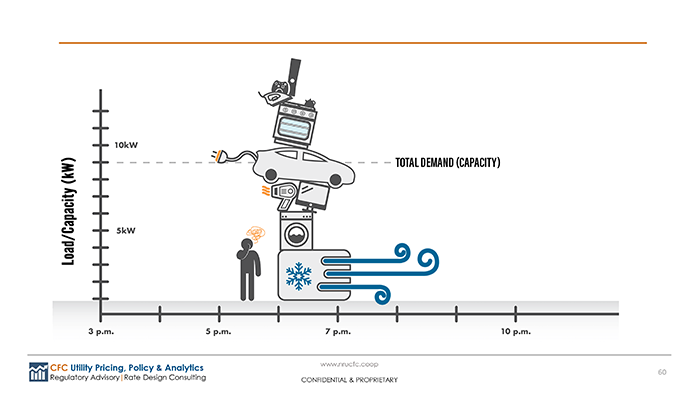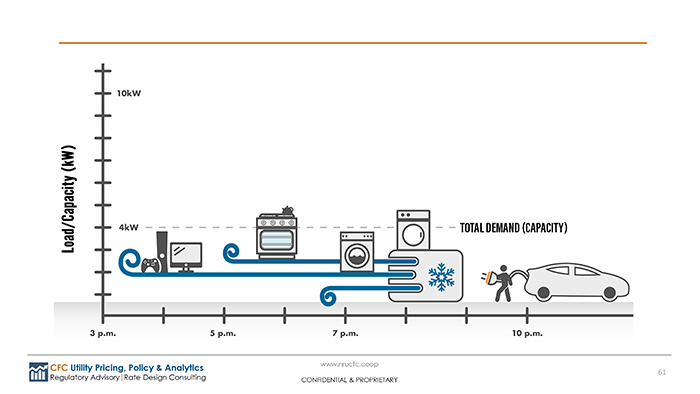Understanding Demand
On your October 10,2025 electric bill, you would have seen a new line under current service detail labeled "demand charge." Right now, there's no charge, but this line is there to help you understand how much demand your home is creating. While our three-phase large power members have been familiar with demand charges for years, it's important for residential and three-phase regular members to understand demand that is related to energy usage.
As electricity demand varies throughout the day, grid operators, power plant operators, and electric utilities work to forecast, plan, and purchase enough electricity for everyone. Central Iowa Power Cooperative, (CIPCO), is our generation and transmission cooperative that we purchase our power from, and we, T.l.P. REC, are member-owners of CIPCO along with twelve other cooperatives. When we receive our monthly power bill from them, it has two major components; demand and energy.
 Demand is the maximum capacity needed to provide the electrical service you expect. Over the years, we have focused on energy only with residential and three-phase regular rate designs. By managing and reducing peak demand, we can alleviate stress on the grid and enhance overall reliability.
Demand is the maximum capacity needed to provide the electrical service you expect. Over the years, we have focused on energy only with residential and three-phase regular rate designs. By managing and reducing peak demand, we can alleviate stress on the grid and enhance overall reliability.
The more electricity you use simultaneously the demand increases during that time period. This requires the generation plants to produce more power in less time to meet your demand and creates additional strain on the transmission lines. Demand is a driver behind your electric bill fluctuations season to season and year to year, as it is not the same every day. Peak demand is when the demand for power is the highest and therefore results in higher costs. If we all level out our load, together we can lower our demand.
But what exactly is "demand" when it comes to electricity? Simply put, demand is like a speedometer.
Get in the driver's seat of your car for a moment. Energy (kWh) would be what is recorded on your car's odometer - a measurement of total miles. Demand (kW) is like your speedometer - measuring the speed at which the energy flows. The demand reading is like the highest recorded "miles-per-hour" speed for that month.
Think of the electrical grid like a freeway. It has to be built to accommodate the largest amount of traffic it could see at one time even if there are only a few cars using it most of the time. During "high traffic" or high-demand times, energy is more expensive. By spreading out your electricity use throughout the day and evenings, you can help the cooperative save on high-demand charges. That savings is passed onto members and ensures a more reliable and balanced grid for everyone.
Demand Questions & Answers
When a power supply and demand imbalance occurs, T.I.P. REC has to pay more for power. The addition of a demand charge reflects the way your cooperative pays for wholesale power. A demand charge accounts for these higher grid costs during times of peak demand. This change will better align member rates with the cost of wholesale power. The demand charge will be effective May 1, 2026 (June 10, 2026 bill).
"Demand" measures the highest amount of power used at one time each month. Running more appliances and devices at once increases your demand. The average demand is measured in kW (kilowatts) on the general service (main) meter.
You can track your demand several ways.
- On your bill: Your monthly demand is posted in the Current Service Detail section of the bill.
- SmartHub: View in real-time through the SmartHub mobile app or through SmartHub on our website. In the menu, select Usage, then Usage Explorer, change the Usage Type to [kWh and Demand (kW)], and a line will appear to show your demand.

DON'T STACK YOUR LOAD |
LEVEL OUT YOUR LOAD |

|

|
As more appliances in your home run at the same time, your demand for power increases. Certain appliances - such as electric ovens, dishwashers, and clothes dryers - demand more power from the grid.
That's why not running them at the same time is important to minimize demand. Lower your demand by not using too many high-power appliances at the same time. By spreading out your electric use, you will have more control over your electric bill and help T.I.P. REC lower overall peak demand costs as well.


